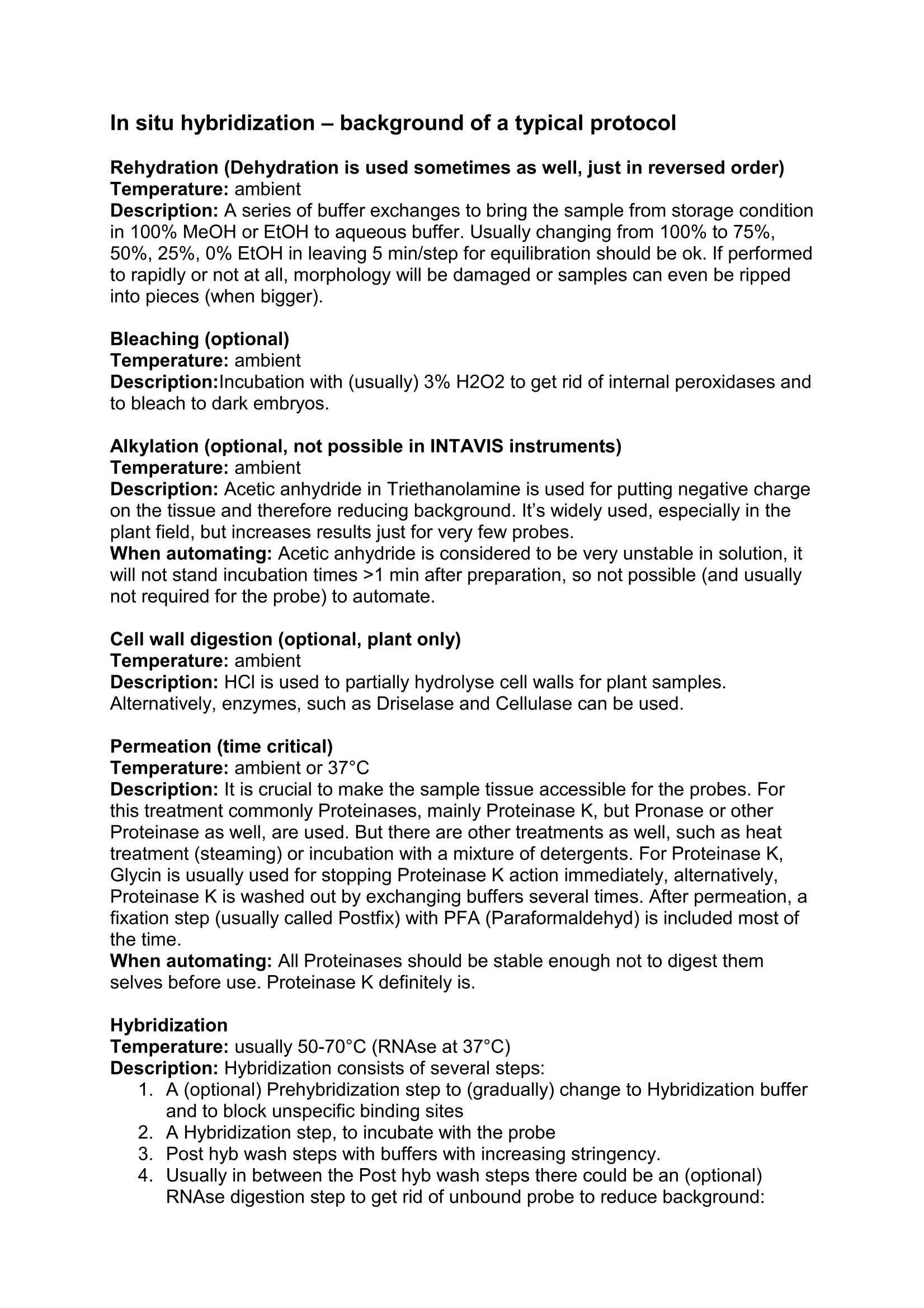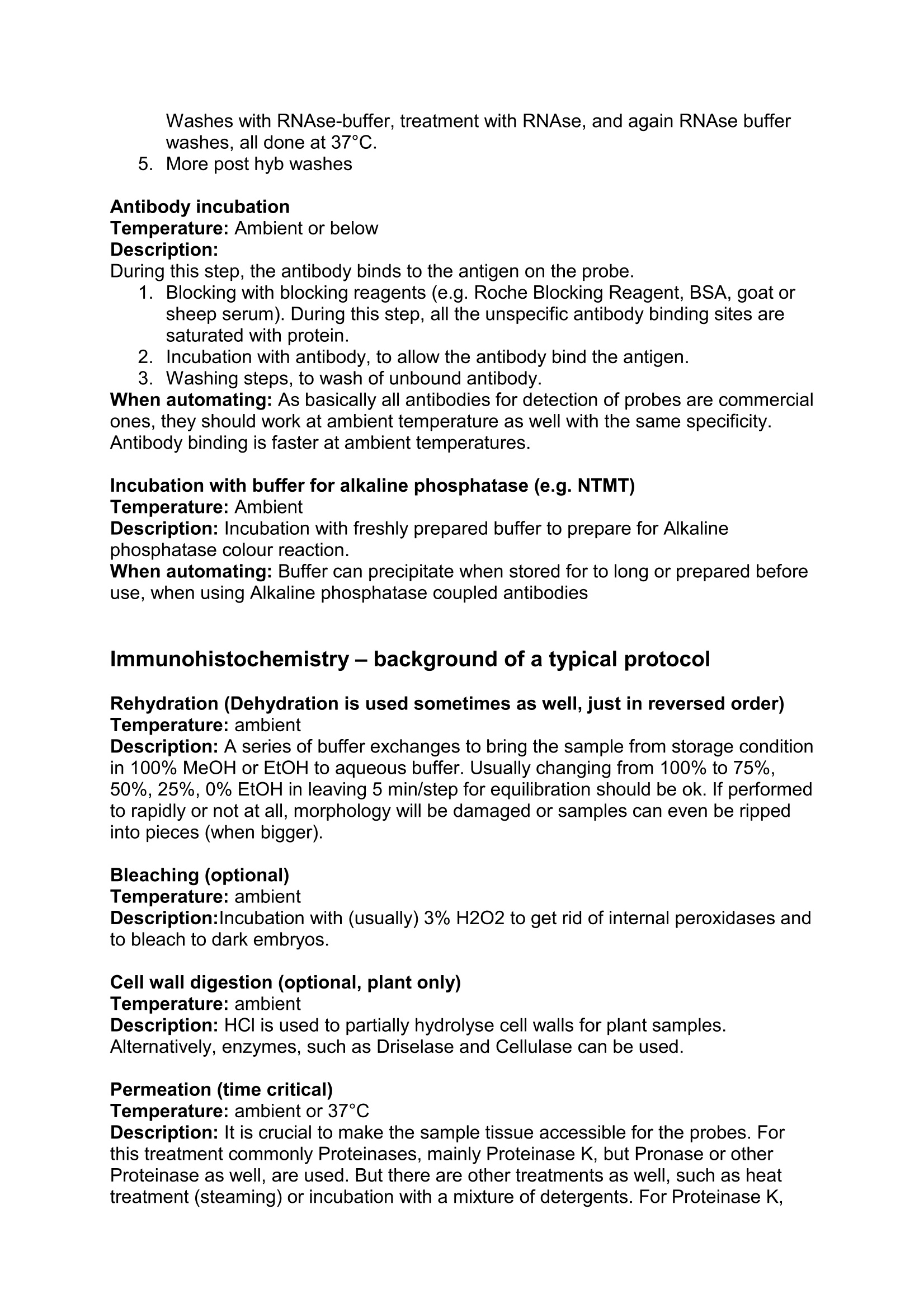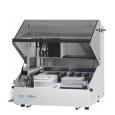方案详情
文
CEM集团的子公司Intavis 公司从2007年开始向全球推出了适用于全组织和切片标本的自动化原位杂交及免疫组化系列产品。通过对以往型号的大幅改进,使得InsituPro 更加满足用户的需求并使得用户对实验的应用更加高效。
方案详情

复水(有时候也用到脱水,只是顺序相反)温度:环境描述:通过一系列的缓冲液交换将样品从在100% 甲醇或乙醇的储存条件中转移到水缓冲液中。通常从100%的乙醇交换到75%、50%、25%、0%,每次交换后留5 min进行平衡即可。如脱水进行太快或不进行脱水,样品形态将被破坏,甚至被撕成碎片。漂白(可选)温度:环境描述:通常与3%的过氧化氢孵育,以摆脱内部的过氧化物酶和漂白暗色的胚胎 烷基化(可选,INTAVIS仪器不能完成)温度:环境描述:三乙醇胺中的乙酸酐用于使组织带负电荷,从而降低背景。它被广泛应用,特别是在植物领域,用极少的探针就可以增强结果。自动化时:乙酸酐在溶液中非常不稳定,它在制备后能用于孵育的时间不超过一分钟,因此不可能实现自动化(并且探针通常不需要)。细胞壁消化(可选,只在植物中)温度:环境描述:植物样品中主要使用盐酸水解细胞壁。或者如崩溃酶和纤维素酶等酶类也能被使用。 渗透(时间要求严格)温度:环境或37℃描述:使探针能接触样品组织至关重要。这步处理通常使用蛋白酶,主要是蛋白酶K,但链霉蛋白酶和其他蛋白酶也能被使用。但也有其他的处理方法,如热处理(蒸汽)或与洗涤剂混合物孵育。对于蛋白酶K,甘氨酸通常被用来立即停止蛋白酶K的作用,或者通过数次换液将蛋白酶K 洗掉。渗透后,通常会使用多聚甲醛进行固定。自动化时:所有蛋白酶应足够稳定,到使用前不会自我分解,如蛋白酶K。 杂交温度:通常50-70℃(RNAse 在37℃)描述:杂交由几步组成:1,预杂交步骤(可选)逐步交换杂交 缓冲液,并封闭非特异结合位点2,杂交步骤,与探针孵育3,杂交后洗涤步骤,用越来越严格的缓冲液进行多次洗涤4,通常在杂交后洗脱步骤之间,进行RNAse消化(可选)来摆脱未结合的探针减少背景:RNAse缓冲液洗涤,用RNAse处理,再次RNAse缓冲液洗涤,所有步骤在37℃进行。5,更多的杂交后洗涤抗体孵育温度:环境或更低描述:在此步骤中,抗体与探针上的抗原结合1. 用封闭试剂封闭(如Roche 封闭试剂,BSA,山羊或绵羊血清)。在这一步,所有非特异抗体结合位点将被蛋白饱和2, 与抗体孵育,让抗体抗原结合3, 洗涤步骤,洗涤未结合抗体自动化时:由于基本上所有检测探针的抗体都是商业化的,它们室温下工作并具有相同的特异性。抗体结合在室温下更快结合。 与碱性磷酸酶缓冲液孵育(如NTMT)温度:环境描述:与新鲜制备的缓冲液孵育,为碱性磷酸酶颜色反应做准备自动化时:使用碱性磷酸酶偶联抗体时,缓冲液储存过久或使用前制备时会沉淀。In situ hybridization – background of a typical protocol Rehydration(Dehydration is used sometimes as well, just in reversed order) Temperature: ambient Description: A series of buffer exchanges to bring the sample from storage condition in 100% MeOH or EtOH to aqueous buffer. Usually changing from 100% to 75%,50%, 25%, 0% EtOH in leaving 5 min/step for equilibration should be ok. If performed to rapidly or not at all, morphology will be damaged or samples can even be ripped into pieces(when bigger). Bleaching(optional) Temperature: ambient Description:Incubation with(usually) 3% H2O2 to get rid of internal peroxidases and to bleach to dark embryos. Alkylation(optional, not possible in INTAVIS instruments) Temperature: ambient Description: Acetic anhydride in Triethanolamine is used for putting negative charge on the tissue and therefore reducing background. It’s widely used, especially in the plant field, but increases results just for very few probes. When automating: Acetic anhydride is considered to be very unstable in solution, it will not stand incubation times>1 min after preparation, so not possible(and usually not required for the probe) to automate. Cell wall digestion(optional, plant only) Temperature: ambient Description: HCl is used to partially hydrolyse cell walls for plant samples. Alternatively, enzymes, such as Driselase and Cellulase can be used. Permeation(time critical) Temperature: ambient or 37°C Description: It is crucial to make the sample tissue accessible for the probes. For this treatment commonly Proteinases, mainly Proteinase K, but Pronase or other Proteinase as well, are used. But there are other treatments as well, such as heat treatment(steaming) or incubation with a mixture of detergents. For Proteinase K, Glycin is usually used for stopping Proteinase K action immediately, alternatively, Proteinase K is washed out by exchanging buffers several times. After permeation, a fixation step(usually called Postfix) with PFA(Paraformaldehyd) is included most of the time. When automating: All Proteinases should be stable enough not to digest them selves before use. Proteinase K definitely is. Hybridization Temperature: usually 50-70°C(RNAse at 37°C) Description: Hybridization consists of several steps: 1.A(optional) Prehybridization step to(gradually) change to Hybridization buffer and to block unspecific binding sites 2.A Hybridization step, to incubate with the probe 3.Post hyb wash steps with buffers with increasing stringency. 4.Usually in between the Post hyb wash steps there could be an(optional) RNAse digestion step to get rid of unbound probe to reduce background: Washes with RNAse-buffer, treatment with RNAse, and again RNAse buffer washes, all done at 37°C. 5.More post hyb washes Antibody incubation Temperature: Ambient or below Description: During this step, the antibody binds to the antigen on the probe. 1.Blocking with blocking reagents(e.g. Roche Blocking Reagent, BSA, goat or sheep serum). During this step, all the unspecific antibody binding sites are saturated with protein. 2.Incubation with antibody, to allow the antibody bind the antigen. 3.Washing steps, to wash of unbound antibody. When automating: As basically all antibodies for detection of probes are commercial ones, they should work at ambient temperature as well with the same specificity. Antibody binding is faster at ambient temperatures. Incubation with buffer for alkaline phosphatase(e.g. NTMT) Temperature: Ambient Description: Incubation with freshly prepared buffer to prepare for Alkaline phosphatase colour reaction. When automating: Buffer can precipitate when stored for to long or prepared before use, when using Alkaline phosphatase coupled antibodies Immunohistochemistry – background of a typical protocol Rehydration(Dehydration is used sometimes as well, just in reversed order) Temperature: ambient Description: A series of buffer exchanges to bring the sample from storage condition in 100% MeOH or EtOH to aqueous buffer. Usually changing from 100% to 75%,50%, 25%, 0% EtOH in leaving 5 min/step for equilibration should be ok. If performed to rapidly or not at all, morphology will be damaged or samples can even be ripped into pieces(when bigger). Bleaching(optional) Temperature: ambient Description:Incubation with(usually) 3% H2O2 to get rid of internal peroxidases and to bleach to dark embryos. Cell wall digestion(optional, plant only) Temperature: ambient Description: HCl is used to partially hydrolyse cell walls for plant samples. Alternatively, enzymes, such as Driselase and Cellulase can be used. Permeation(time critical) Temperature: ambient or 37°C Description: It is crucial to make the sample tissue accessible for the probes. For this treatment commonly Proteinases, mainly Proteinase K, but Pronase or other Proteinase as well, are used. But there are other treatments as well, such as heat treatment(steaming) or incubation with a mixture of detergents. For Proteinase K, Glycin is usually used for stopping Proteinase K action immediately, alternatively, Proteinase K is washed out by exchanging buffers several times. After permeation, a fixation step(usually called Postfix) with PFA(Paraformaldehyd) is included most of the time. When automating: All Proteinases should be stable enough not to digest them selves before use. Proteinase K definitely is. Primary antibody Temperature: usually ambient or below. Can be 37°C as well. Description: Incubation with the primary antibody is rather simple. Blocking, antibody, washing. As primary antibodies are quite often home made and might not work very good, you might need to incubate them at temperatures below ambient. If the antibodies are good, you could use them at 37°C to decrease incubation time. 1. (Optional) Blocking with blocking reagents(e.g. Roche Blocking Reagent, BSA, goat or sheep serum). During this step, all the unspecific antibody binding sites are saturated with protein. 2.Incubation with antibody, to allow the antibody bind the antigen. 3.Washing steps, to wash of unbound antibody. Secundary antibody incubation Temperature: Ambient or below Description: During this step, the secondary antibody binds to primary ones. 1.Blocking with blocking reagents(e.g. Roche Blocking Reagent, BSA, goat or sheep serum). During this step, all the unspecific antibody binding sites are saturated with protein. 2.Incubation with antibody, to allow the antibody bind the antigen. 3.Washing steps, to wash of unbound antibody. When automating: As basically all antibodies for detection of probes are commercial ones, they should work at ambient temperature as well with the same specificity. Antibody binding is faster at ambient temperatures. Incubation with buffer for alkaline phosphatase(e.g. NTMT) Temperature: Ambient Description: Incubation with freshly prepared buffer to prepare for Alkaline phosphatase colour reaction, when using Alkaline phosphatase coupled antibodies. When automating: Buffer can precipitate when stored for to long or prepared before use.
确定



还剩1页未读,是否继续阅读?
培安有限公司为您提供《全组织和切片标本中原位杂交检测方案(多肽合成仪)》,该方案主要用于其他中其他检测,参考标准--,《全组织和切片标本中原位杂交检测方案(多肽合成仪)》用到的仪器有INTAVIS 阵列肽+平行多肽合成仪
相关方案
更多
该厂商其他方案
更多










